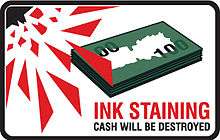Intelligent banknote neutralisation system
An intelligent banknote neutralisation system (IBNS) is a security system which protects valuables against unauthorised access to its contents by rendering it unusable by marking all the cash as stolen by a degradation agent when an attempted attack on the system is detected. Ink is a popular agent, which functions by staining cash with a permanent dye. Such marked money is highly conspicuous and cannot be readily used.
Well neutralised banknotes cannot be brought back into circulation easily. They can be linked to the crime scene and restricted procedures are in place to exchange them at the financial institution. This makes stealing neutralised banknotes uneconomical and impractical. The IBNS removes the anticipated reward of the crime and increases the risk of being caught. This not only foils the theft but acts as a deterrent against further attacks.



History
In Europe the design of intelligent systems to protect valuables began in 1980. The overall goal was to create a secure system to provide additional security for Cash-in-transit. The very first IBNS prototype using coloured smoke as neutralisation agent was invented in UK ([Saltash]) by the UK company Spinnaker in 1982. This made use of very lightweight and simple to use containers. In 1990 the first industrialized End-to-End IBNS using security ink as a neutralization agent and accepted to be used in soft-skinned vehicles was introduced to the Belgium market by French company Axytrans.[1] At the same time in Sweden IBNS systems manufactured by Spinnaker using coloured smoke were being used in soft-skinned vehicles to great effect, showing that they were a viable alternative to cash transport using armoured trucks.
In 1991 France changed its regulations to allow the use of IBNS in soft-skinned vehicles. The French CIT company VALTIS was the first to implement such a system to service three regional banks.
In 2002, Banque de France implemented an international procedure to treat and exchange neutralized banknotes for CIT professionals.
In 2003, the European Central Bank made a decision that defined the process and cost of exchanging neutralized Euro Banknotes among all National Central Banks in Europe.[2]
In 2005, Banque de France implemented a special procedure regarding the treatment of stained banknotes deposited by private persons.
In 2007, Sweden implemented a national regulation making the use of IBNS by CIT obligatory. The same year, the Belgian government also implemented a national regulation imposing the use of IBNS for Cash-in-transit.
In 2010, the European Commission finalized a European regulation to harmonize cross-border cash transportation by road. The use of non-armoured vehicles in combination with IBNS is one of two accepted methods of transportation.[3]
Concept
The concept of an intelligent banknote neutralisation system (IBNS) is based upon the notion that criminals seek to maximize their reward while minimizing the potential cost of the crime.[4] Intelligent Banknote Neutralisation Systems remove the anticipated reward of the crime and increase the risk of being caught.
Reducing the reward of the crime is done by permanently marking the cash as stolen with an indelible security ink. Tracers and markers added to the ink provide forensic evidence linking the criminal to the crime scene, increasing the risk of being caught.
IBNS focuses on using technology to protect people, valuables and equipment whilst minimizing the use of weapons and armoured vehicles.
Legislation and regulations
The use of IBNS is usually regulated by the presence or absence of a legal structure (legislation and regulations) as well as the legal conditions applying to the private security sector.
These countries allow neutralising of national banknotes by the National Central Bank:
- Permit the use of IBNS without legal or professional regulation or other restriction: Latvia, Lithuania, Estonia, Bosnia, Slovenia, UK, Austria, Netherlands, Austria, Switzerland.
- Legal regulation permits use of IBNS upon citing the regulation: Italy, Netherlands, Norway, Denmark, Finland.
- Legal regulation permit to use IBNS with technical agreement: Croatia, France, Sweden, Belgium, Germany, Ireland, Luxembourg, Hungary, Italy
- Legal regulation forbids unrestricted use of IBNS: Poland, Romania, Spain.
These countries forbid neutralising of national banknotes by legal regulation or internal regulation by the National Central Bank: Indonesia, Philippines, Thailand, Egypt and others.
Market
There are six major global players in this market: 3SI, Spinnaker, SQS, Villiger, Gehrer, and Oberthur Cash Protection; these companies export IBNS to many countries worldwide. They are members of EURICPA – European Intelligent Cash Protection Association. EURICPA focuses on promoting ink staining technology as the most secure and safe solution for CIT.
The top three players in the IBNS market are 3SI (greatest number of IBNS to protect ATMs), Oberthur Cash Protection (greatest total number of systems in use and highest turnover) and Spinnaker (largest number of countries covered). Smartstain is the most recent technology to come to market and currently has the fastest growth rate in the field of protecting ATMs.
There are several smaller companies manufacturing IBNS for local markets.
References
- ↑ , Fédération Bancaire Française. Transport de fonds : les systèmes alternatifs.
- ↑ , DECISION OF THE EUROPEAN CENTRAL BANK of 20 March 2003 on the denominations, specifications, reproduction, exchange and withdrawal of euro banknotes. EUROPEAN CENTRAL BANK.
- ↑ , Commission proposal for an EU Regulation to facilitate professional cross-border transportation of euro cash by road. European Commission
- ↑ , Barthe, Emmanuel. Crime Prevention Publicity Campaigns. U.S. Department of Justice. 2006, p.9.
External links
- EURICPA - European Intelligent Cash Protection Association
- Banknote Watch - a crime prevention initiative
- Vigie Billet - a citizen’s initiative
- Oberthur Cash Protection - largest European manufacturer of IBNS